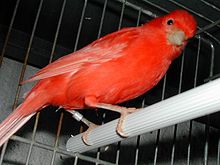
The red factor canary is a variety of domestic canary, named after its colorful plumage. It is a bird commonly kept as a pet and for showing.
Description
The red factor canary averages about 5+1⁄2 inches (14 cm) in length. This variety of canary tends to be bred for the novelty of its color, rather than for its song.
It was developed as a cross between another type of finch — the now-endangered Venezuelan red siskin (Spinus cucullatus) — and a yellow domestic canary (Serinus canaria domestica).
In breeding/showing, domestic canaries are broken down into two types based on pigmentation: melanics and lipochromes. Melanics contain melanin markings over top of lipochromes in their feathers, while lipochrome canaries have feathers that contain no melanin in their pigmentation. The red factor canary is classified as a lipochrome.
There are two types of red factor canaries based on the lipochrome distribution in their plumage: intensive red factors and non-intensive red factors. Intensive red factors are characterized by even lipochrome distribution throughout their feathers, giving the plumage a bright and uniform appearance throughout. Birds with non-intensive coloration have feathers that lack pigmentation at the tips — referred to as frosting due to the appearance — this makes for a more subdued brightness in appearance than birds with intensive coloration.
Availability
Red factor canaries are usually available at most pet stores and can also be found through bird shows, bird clubs, breeders and on the internet.
See also
- Atlantic canary (wild canary)
- Australian plainhead
- Harz Roller
References
- "The Red Factor Canary". www.canaryadvisor.com. Archived from the original on 2008-08-18. Retrieved 2008-08-11.
- Goldman, Steve (February 15, 2004). "A brand-new bird: how two amateur scientists created the first genetically engineered animal". The Journal of Clinical Investigation. 113 (4): 495–495. doi:10.1172/JCI21127. PMC 338274. Archived from the original on June 15, 2024. Retrieved June 28, 2024 – via www.jci.org.
- canariasacross (2023-12-06). "Discover the Fascinating World of Domestic Canaries and Their Unique Characteristics". Canary Islands, Spain. Retrieved 2024-10-03.
- Culture, Canary (2023-11-30). "Understanding Classic Melanic Canaries". Canary Culture. Retrieved 2024-10-03.
- Culture, Canary (2023-10-18). "Understanding Lipochrome Canaries". Canary Culture. Retrieved 2024-10-03.